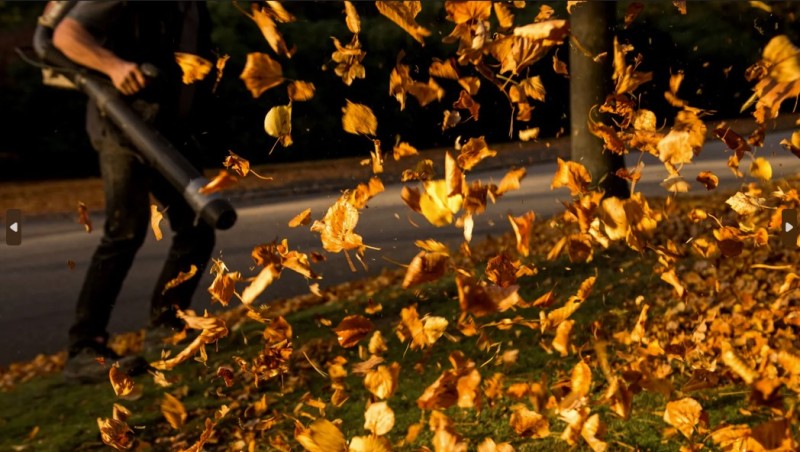For more than 100 million years, trees have dropped their leaves every fall, creating a protective layer of duff that provides cover for snails, bees, and butterflies. Decaying leaves fertilized the soil and gave nutrients back to the trees. Today, fallen leaves still provide a harvest festival of benefits — unless they get blasted into oblivion with a leaf blower.
Across the United States, some 11 million leaf blowers roar into action every year, obliterating delicate debris with 200-mile-per-hour winds. Their distinctive, whining drone has been hard to escape. But restrictions on leaf blowers have been spreading across the country, permitting some lucky locales to experience the season as nature intended, at a humane decibel level.
Outright bans on the gas-powered machines have recently taken effect in Washington, D.C.; Miami Beach, Florida; and Evanston, Illinois. California will end the sale of gas-powered blowers next summer. Their hum will also be silenced in Portland and Seattle in the coming years. Barring a sudden acceptance of lawns scattered with leaves, rakes and battery-powered devices will slowly replace them.
Long the dream of noise-sensitive people everywhere, bans started taking off after pandemic lockdowns in 2020 forced office workers into their homes. Stuck in their neighborhoods all day, people discovered the beauty of birdsong, along with a newfound loathing for the whine of the leaf blowers.
Communities that had tried and failed to get restrictions on the devices are now starting to see success, said Jamie Banks, the co-founder and president of Quiet Communities, a nonprofit dedicated to reducing noise pollution: “There’s a lot more consensus around doing something about it.” Today, more than 200 towns across the United States have restrictions on leaf blowers in place, though many just put limits on what hours or times of year people can operate them.
Another factor behind the spread of bans is research showing that leaf blowers emit a shocking amount of air pollution. The California Air Resources Board has estimated that operating a gas-powered leaf blower for an hour emits as much smog-forming polluting as driving a Toyota Camry from Los Angeles to Denver. How is that even possible? Many leaf blowers use a wildly inefficient “two-stroke” engine, which mixes oil and gasoline and spits out as much as a third of that fuel as unburned aerosol. The outdated design is cheap, powerful, and really loud and dirty.
“I definitely think people underestimate the risks,” said Michael Brauer, a professor of public health at the University of British Columbia.
A study in 2015 found that lawn mowers, trimmers, leaf blowers, and other lawn equipment accounted for a quarter of all emissions of cancer-causing benzene in 2011, the most data available. They also accounted for 17 percent of volatile organic compounds and 12 percent of nitrogen oxides, the primary pollutants of smog, and were responsible for 20 million tons of planet-warming carbon dioxide emissions — about 4 percent of what passenger cars emitted in 2011.
“The big picture is that cars have gotten cleaner and cleaner and cleaner and cleaner, and this kind of equipment has not,” Brauer said. “And so this has become evident as a more important source of pollution.” Because vehicle regulations have become so strict in California, for example, small, off-road engines like those found in leaf blowers emit more smog-producing emissions than all the 14 million passenger cars in the state.
Even their noise poses a health concern. Gasoline-powered leaf blowers operate at a low frequency, allowing the noise to carry over long distances and penetrate through walls. “People can’t get away from the sound,” Banks said. “So you go in your house, you close your windows, you shut your doors, and you can still hear it.”
A study conducted by Banks and the EPA in 2017 found that commonly used lawn equipment was louder than the World Health Organization’s recommended limit of 55 decibels up to 800 feet away. And every 5-decibel increase in the average daily noise level around people’s home leads to a 34 percent increase in heart attacks and strokes, according to Harvard research in 2020.
A family lounges in their front yard in a suburban neighborhood, circa 1955. Lambert / Getty Images)
So why did such a dangerous device take off in the first place? The first leaf blower-like machines, invented in the late 1940s, weren’t intended to blow leaves — they were backpack crop dusters, meant for spraying pesticides. Then someone had the brilliant idea of removing the chemical canister so that all the machine could do was blast away debris. The invention coincided with the development of the suburbs after World War II, when having a carpet of grass around your home became part of the American dream. Fallen leaves were seen as a nuisance that needed removing: They covered up the green lawns everyone wanted to show off and turned sidewalks slippery in the rain.
So in the 1970s, the Japanese company that had invented the crop duster, Kyoritsu Noki, started selling what the people wanted... https://grist.org/solutions/leaf-blower-bans-air-pollution-noise/




